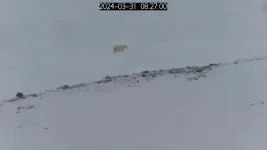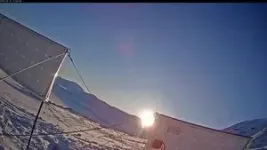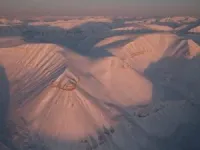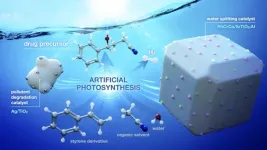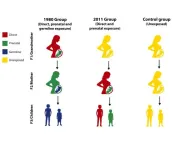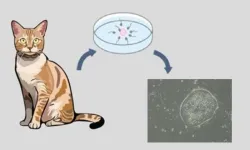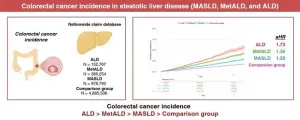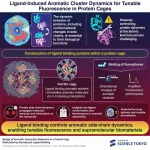(Press-News.org) Svalbard, Norway – February 27, 2025 – Researchers from Polar Bears International, San Diego Zoo Wildlife Alliance, the Norwegian Polar Institute, and the University of Toronto Scarborough reveal the first detailed look at polar bear cubs emerging from their dens, captured through nearly a decade of remote camera footage in Svalbard, Norway. This research, published today on International Polar Bear Day in the Journal of Wildlife Management, marks the first combination of satellite tracking collars with remote camera traps to answer questions about polar bear denning, which is notoriously difficult to study as polar bear moms build their dens under the snow in remote areas. The researchers present new insights into the timing of den emergence and post-emergence behaviors alongside new tools to monitor polar bear dens across the Arctic. Cub survival underpins species survival, and the denning period is the most vulnerable period of their life– less than 50% of cubs may make it to adulthood. As industry expands in the Arctic, the study highlights the importance of undisturbed denning areas to protect polar bear populations.
“Polar bear mothers are having increasing difficulties reproducing due to climate-driven changes, and are likely to face further challenges with the expansion of the human footprint in the Arctic,” says Dr. Louise Archer, lead author and Polar Bears International Postdoctoral Fellow at the University of Toronto Scarborough, adding, “We’re excited to introduce new tools to monitor bears during this vulnerable time and to gain insight into their behavior across the Arctic, so that we can work to protect cubs and therefore the species. Every den we monitored had its own story, every data point adds to our understanding of this crucial time and supports more effective conservation strategies.”
Key Findings:
Altered Den Emergence Periods: The researchers report that families emerged around March 9th in Svalbard, and appeared to abandon the den earlier than previously recorded in this population, with further monitoring required to establish whether this is a continuing trend. Changing the timing of denning could potentially jeopardize cub survival as cubs have less time to develop before venturing further afield to the sea ice.
Variable Den Presence: In some cases, bears emerged from the den for less than a minute before going back inside, while other emergences lasted several hours. In terms of departing the den for good, the camera footage indicated that polar bears remain near their dens for an average stay of 12 days. However, this varied greatly between polar bear families, ranging from 2 to 31 days.
Den Switching: Some moms switched dens – they left their original dens and were observed moving their family to a new den.
Maternal Dependence: Cubs rely heavily on their mothers, rarely venturing outside the den alone. Cubs were seen without their moms only 5% of the time. In Svalbard, cubs depend on their mom for up to 2.5 years.
Circumpolar Conservation Implications: The study underscores the need for monitoring and protection of denning areas to ensure the survival of future generations because cubs rely on the den emergence period to acclimatize to the external environment and to prepare for life outside the den.
Introducing Wildlife Management Tools: The researchers combined collar data and timelapse cameras both to uncover insights about denning behavior and to create a data-driven tool to understand polar bear denning across the Arctic. This research provides the foundation for improved wildlife management, enabling the reduction of potential clashes between polar bear denning areas and human activity.
“This study provides a rare glimpse into one of the most vulnerable and critical periods in a polar bear’s life, offering insights that can help guide our collective conservation efforts,” says Dr. Megan Owen, Vice President of Wildlife Conservation Science at San Diego Zoo Wildlife Alliance. “By combining innovative technology with long-term research, we’re gaining a deeper understanding of the challenges polar bear moms and cubs face in a rapidly changing Arctic. Protecting denning habitats is essential for population health, and this study provides invaluable insights that will help guide protective management.”
“Studies including observational data at polar bear den sites have been few, and this study thus contributes significantly to our knowledge about denning ecology,” says Dr. Jon Aars, Senior Researcher at the Norwegian Polar Institute, adding, “Further, as the data from satellite radio collars were available for all the mothers, the observational data made it possible to tell how changes in activity and temperature recorded correspond with behavior. This is of great value as a lot of data from collared females that have been in a maternity den is available.”
Methodology: Female polar bears were fitted with GPS satellite collars that recorded their location, temperature, and activity. Researchers used these collar data to locate dens, and they traveled through Svalbard’s mountains to deploy timelapse camera traps at thirteen den sites over six years (2016 - 2020 and 2023). The study found that camera traps provided fine-scale insights into maternal den behavior, while satellite collars are accurate and useful for monitoring bears over longer periods and in more remote areas.
What are polar bear cubs doing right now? Newborn polar bear cubs are currently snuggled in dens with their mothers across the Arctic. Polar bears typically give birth around New Year, at which point the cubs are blind, hairless, and just a 1/2 kg (or 1 lb). They grow quickly, nursing on their mom’s milk which is 31% fat, reaching around 10kg – up to 20 times their birth weight – by the time they leave the den in spring. Polar bears emerge from their birthing dens between February and April of each year, with the timing varying depending on where they live– Polar Bears International created International Polar Bear Day (February 27th) to honor the time when moms and cubs are about to exit their dens. The duration of the denning period, timing of den emergence, and time spent at the den site after emergence all contribute to the survival of polar bear cubs.
## end of release ##
About Polar Bears International
Polar Bears International’s mission is to conserve polar bears and the sea ice they depend on. The organization works to inspire people to care about the Arctic, the threats to its future, and the connection between this remote region and our global climate. Polar Bears International is the only nonprofit organization dedicated solely to wild polar bears and Arctic sea ice, and the staff includes scientists who study wild polar bears. The organization is a recognized leader in polar bear conservation. For more information, visit www.polarbearsinternational.org.
Media Contacts
Annie Edwards, for Polar Bears International
annie@fabricmedia.net
+44 0 7307 139782
About The Norwegian Polar Institute
The Norwegian Polar Institute (NPI) provides scientific knowledge about the Arctic and the Antarctic and advice to the Norwegian authorities. NPI has the main responsibility for polar bear research in Svalbard, and has conducted research on polar bears since the 1960s. The main office is in Tromsø, Norway, but NPI also has offices in Longyearbyen and Ny Ålesund, Svalbard.
About San Diego Zoo Wildlife Alliance
San Diego Zoo Wildlife Alliance, a nonprofit conservation leader, inspires passion for nature and collaboration for a healthier world. The Alliance supports innovative conservation science through global partnerships and groundbreaking efforts at the world-famous San Diego Zoo and San Diego Zoo Safari Park, both leading zoological institutions and accredited botanical gardens. Through wildlife care expertise, cutting-edge science and continued collaboration, more than 44 endangered species have been reintroduced to native habitats. The Alliance reaches over 1 billion people annually through its two conservation parks and media channels in 170 countries, including San Diego Zoo Wildlife Explorers television, available in children’s hospitals across 14 countries. Wildlife Allies—members, donors and guests—make success possible.
About the University of Toronto Scarborough
Founded in 1964, the University of Toronto Scarborough is an anchor institution in the eastern Greater Toronto Area. Situated in one of Toronto’s most diverse and multicultural neighbourhoods, the campus fosters a vibrant culture of community engagement. Here, students cross academic and geographic boundaries in their pursuit of knowledge. Experiential learning is one of the hallmarks of our approach to education. We are proud to be part of the University of Toronto, recognized as the most sustainable university in the world and Canada’s top university. U of T has a long history of challenging the impossible and transforming society through the ingenuity and resolve of its faculty, students, alumni and supporters. We are part of one of the top research-intensive universities, bringing together top minds from every conceivable background and discipline to collaborate on the world’s most pressing challenges. Together, we continue to defy gravity by taking on what might seem unattainable today and generating the ideas and talent needed to build a more equitable, sustainable and prosperous future.
END
Polar bear cubs emerging from their dens for the first time: New study captures rare footage
Remote cameras were deployed in the Arctic mountains across nearly a decade; Valuable footage of moms and cubs emerging from dens shines light on elusive polar bear reproduction
2025-02-27
ELSE PRESS RELEASES FROM THIS DATE:
Turning waste organic compound into useful pharmaceuticals and energy using a technique inspired by photosynthesis
2025-02-27
A research team led by Assistant Professor Shogo Mori and Professor Susumu Saito at Nagoya University has developed a groundbreaking method of artificial photosynthesis that uses sunlight and water to produce energy and valuable organic compounds, including pharmaceutical materials, from waste organic compounds. This achievement represents a significant step toward sustainable energy and chemical production. The findings were published in Nature Communications.
“Artificial photosynthesis involves chemical reactions ...
Violence alters human genes for generations, researchers discover
2025-02-27
In 1982, the Syrian government besieged the city of Hama, killing tens of thousands of its own citizens in sectarian violence. Four decades later, rebels used the memory of the massacre to help inspire the toppling of the Assad family that had overseen the operation.
But there is another lasting effect of the attack, hidden deep in the genes of Syrian families. The grandchildren of women who were pregnant during the siege — grandchildren who never experienced such violence themselves — nonetheless bear marks of it in their genomes. ...
Scientists discover key protein in resilience to stress
2025-02-27
When faced with chronic stress, why do some people develop anxiety and depressive symptoms while others show resilience? A protein that acts as a cannabinoid receptor and is present in the structure controlling exchanges between the bloodstream and the brain could be part of the answer, according to a study published today in Nature Neuroscience.
“The protein, called cannabinoid receptor type 1 (CB1), is part of the blood-brain barrier, the dynamic structure that protects the brain by regulating the passage of molecules between the bloodstream and ...
Nasal spray shows preclinical promise for treating traumatic brain injury
2025-02-27
A new study led by researchers at Mass General Brigham suggests a nasal spray developed to target neuroinflammation could one day be an effective treatment for traumatic brain injury (TBI). By studying the effects of the nasal anti-CD3 in a mouse model of TBI, researchers found the spray could reduce damage to the central nervous system and behavioral deficits, suggesting a potential therapeutic approach for TBI and other acute forms of brain injury. The results are published in Nature Neuroscience.
“Traumatic brain injury is a leading cause of death and disability — including cognitive decline ...
Cambridge initiative to address risks of future engineered pandemics
2025-02-27
Covid-19 showed us how vulnerable the world is to pandemics – but what if the next pandemic were somehow engineered? How would the world respond – and could we stop it happening in the first place?
These are some of the questions being addressed by a new initiative launched today at the University of Cambridge, which seeks to address the urgent challenge of managing the risks of future engineered pandemics.
The Engineered Pandemics Risk Management Programme aims to understand the social and biological factors that might drive an engineered pandemic and to make a major contribution ...
Unmasking inequalities in AI: new research reveals how artificial intelligence might reinforce inequality
2025-02-27
The researchers challenge the widespread belief that AI-induced bias is a technical flaw, arguing instead AI is deeply influenced by societal power dynamics. It learns from historical data shaped by human biases ,absorbing and perpetuating discrimination in the process. This means that, rather than creating inequality, AI reproduces and reinforces it.
“Our study highlights real-world examples where AI has reinforced existing biases.” Prof. Bircan says. “One striking case is Amazon’s AI-driven hiring tool, which was found to favor male candidates, ultimately reinforcing gender disparities in the job market. Similarly, government AI fraud detection ...
Taking sports science in her stride: How Dr. Nerea Casal García aims to maximize performance on the track
2025-02-27
The following is a Q&A with Dr Nerea Casal García, a sports scientist focusing on sports training and performance optimization. To speak to the author, or to receive an advance copy of the paper, please write to: press@frontiersin.org The paper will be published on 27 Feb 2025 06:15 CET]
Dr Nerea Casal García is an athlete, personal coach, and injury readaptation specialist who last year completed a PhD on observational analysis in elite sports. Today, she is a professor at the Institut Nacional ...
Pioneering work generates feline embryonic stem cells in boon for cats
2025-02-27
As different as they may seem, humans and cats have similar ailments, but in terms of health care, veterinary regenerative medicine is not as advanced.
A possible solution rests in embryonic stem cells, which can differentiate into various types of cells and be transplanted to restore internal damage. Further, they are characterized by their near-natural state similar to induced pluripotent stem (iPS) cells. Recent research has successfully generated feline iPS cells, but not embryonic stem cells, so research on these cell lines is essential to improve the quality ...
Decoding the link between colorectal cancer risk and steatotic liver disease
2025-02-27
Alcoholic and non-alcoholic fatty liver disease (NAFLD) are well-known risk factors for colorectal cancer (CRC). NAFLD has emerged as a heterogenous disease tightly linked to metabolic dysfunction and has been redefined under the umbrella term ‘steatotic liver disease’ (SLD). However, CRC risk variations across different SLD subgroups remain unknown. Now, researchers from Japan have discovered that the risk of CRC varies significantly among SLD subgroups, with patients with alcoholic liver disease being at higher risk.
Lifestyle-related disorders have become increasingly prevalent, representing a major health ...
Controlling conformational changes in protein aromatic side chains
2025-02-27
Novel protein cage system can control and visualize orientational changes in aromatic side chains upon ligand binding, as reported by researchers at Institute of Science Tokyo. By inducing coordinated molecular changes, this approach enables precise control over protein dynamics while also enhancing fluorescence properties. Their breakthrough could lead to applications in biomolecular robotics, drug delivery, and advancing the development of responsive biomaterials.
The dynamic nature of proteins—their ability to bend, fold, and change shape in response to their environment—underlies ...
LAST 30 PRESS RELEASES:
Scalable and healable gradient textiles for multi‑scenario radiative cooling via bicomponent blow spinning
Research shows informed traders never let a good climate crisis go to waste
Intelligent XGBoost framework enhances asphalt pavement skid resistance assessment
Dual-function biomaterials for postoperative osteosarcoma: Tumor suppression and bone regeneration
New framework reveals where transport emissions concentrate in Singapore
NTP-enhanced lattice oxygen activation in Ce-Co catalysts for low-temperature soot combustion
Synergistic interface engineering in Cu-Zn-Ce catalysts for efficient CO2 hydrogenation to methanol
COVID-19 leaves a lasting mark on the human brain
Scientists use ultrasound to soften and treat cancer tumors without damaging healthy tissue
Community swimming program for Black youth boosts skills, sense of belonging, study finds
Specific depressive symptoms in midlife linked to increased dementia risk
An ‘illuminating’ design sheds light on cholesterol
Who is more likely to get long COVID?
Study showcases resilience and rapid growth of “living rocks”
Naval Research Lab diver earns Office of Naval Research 2025 Sailor of the Year
New Mayo-led study establishes practical definition for rapidly progressive dementia
Fossil fuel industry’s “climate false solutions” reinforce its power and aggravate environmental injustice
Researchers reveal bias in a widely used measure of algorithm performance
Alcohol causes cancer. A study from IOCB Prague confirms damage to DNA and shows how cells defend against it
Hidden viruses in wastewater treatment may shape public health risks, study finds
Unlock the power of nature: how biomass can transform climate mitigation
Biochar reshapes hidden soil microbes that capture carbon dioxide in farmland
Reducing saturated fat intake shows mortality benefit, but only in high-risk individuals
Manta rays create mobile ecosystems, study finds
Study: Mixed results in using lipoic acid to treat progressive multiple sclerosis
Norbert Holtkamp appointed director of Fermi National Accelerator Laboratory
New agentic AI platform accelerates advanced optics design
Biologists discover neurons use physical signals — not electricity — to stabilize communication
Researchers discover that a hormone can access the brain by hitchhiking
University of Oklahoma researcher awarded funding to pursue AI-powered material design
[Press-News.org] Polar bear cubs emerging from their dens for the first time: New study captures rare footageRemote cameras were deployed in the Arctic mountains across nearly a decade; Valuable footage of moms and cubs emerging from dens shines light on elusive polar bear reproduction
